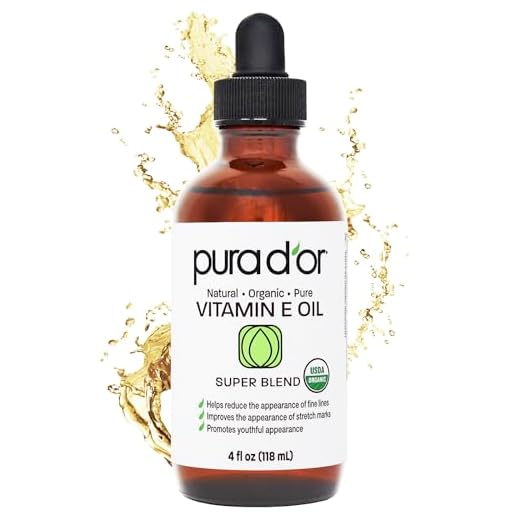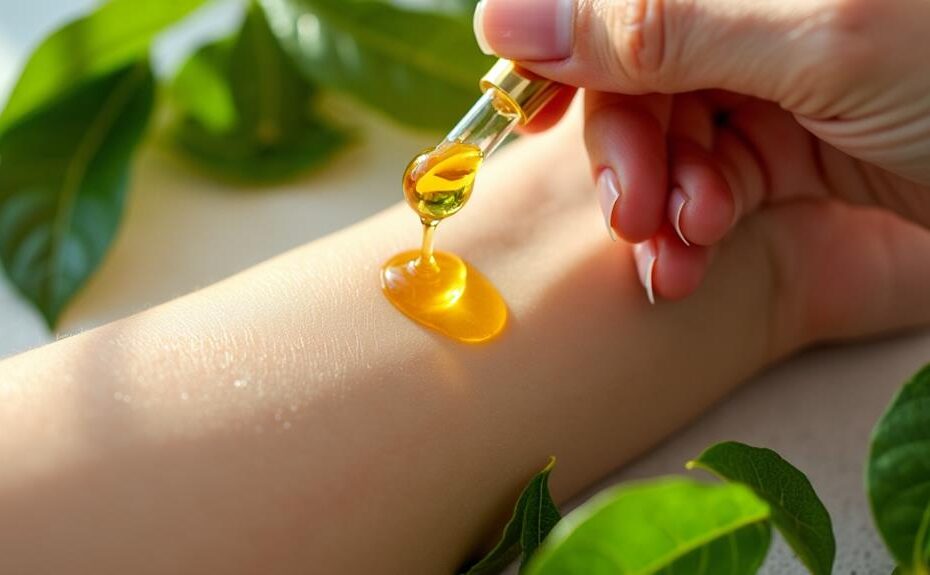







Vitamin E is often marketed for improving scar appearance, but clinical evidence doesn't support this claim. Studies show that a majority of individuals experience little to no benefit, with some even reporting allergic reactions. While topical application may hydrate the skin, it generally doesn't greatly enhance scar healing. Other, more effective treatments such as silicone sheets, massage therapy, and laser therapy present more reliable options for scar management. It's important to consult a healthcare professional for personalized advice on scar treatment that aligns with the latest research findings. You'll discover more effective strategies for scar management shortly.
Key Takeaways
- Current research indicates no significant improvement in scar appearance with topical vitamin E application.
- A 1999 study showed 90% of participants experienced no benefits or worsening of scars with vitamin E.
- Vitamin E can cause allergic reactions, with about 33% of users developing contact dermatitis.
- Effective scar management techniques include silicone sheets, massage therapy, and microneedling, rather than relying on vitamin E.
- Consultation with healthcare professionals is crucial for personalized and evidence-based scar treatment plans.
Overview of Vitamin E
Vitamin E is an essential fat-soluble antioxidant that greatly contributes to skin health by protecting skin cells from the damaging effects of free radicals and oxidative stress. This vitamin plays a crucial role in maintaining skin integrity, and you can obtain it through dietary intake from sources like nuts, seeds, and green leafy vegetables. Topical application of vitamin E is common in skincare products, where it's believed to enhance skin hydration and improve texture. For example, products like Windmill Super Vitamin E Skin Cream highlight the antioxidant properties of vitamin E while providing effective hydration for dry skin.
While anecdotal evidence supports the idea that vitamin E can reduce the appearance of scars, clinical evidence on this topic is mixed. Although some studies suggest a potential benefit, others show limited effectiveness in scar formation and healing. This inconsistency indicates that while vitamin E may support overall skin health, it shouldn't be viewed as a guaranteed solution for scar treatment.
You may consider using topical oils rich in vitamin E for their moisturizing properties, but remember that oral supplements might not directly influence scar healing as effectively as other targeted treatments. Understanding these nuances can help you make informed choices about incorporating vitamin E into your skincare regimen.
Research Findings on Scarring
While vitamin E is widely recognized for its antioxidant properties and potential benefits to skin health, research findings on its effectiveness for improving scar appearance present a more nuanced picture. A notable 1999 study revealed that 90% of participants using topical vitamin E on scars reported no improvement or experienced allergic reactions, casting doubt on its effectiveness. Additionally, a 2016 review emphasized the necessity for more clinical trials to assess vitamin E's role in scar management, highlighting a substantial gap in current evidence. Although some studies suggest that vitamin E may enhance hydration and skin texture, its role in overall skin health, as noted in the Vitamin E-200 200 IU review, remains unclear. The overall data remains insufficient to recommend it specifically for scar reduction. In fact, a 2008 study indicated that scars typically fade over time, with fine-line scars taking up to two years to flatten, suggesting that natural healing processes may outweigh the impact of topical treatments like vitamin E. Particularly for keloid scars, limited data indicates no significant benefits from vitamin E, emphasizing the need for alternative scar management techniques. Consequently, while vitamin E may offer some skin benefits, its effectiveness in scar treatment is still largely unproven.
Mechanism of Scar Formation
Scarring is an essential part of the body's healing process, occurring after injuries, surgeries, or skin conditions. When an injury occurs, the body initiates an inflammatory response, activating the immune system to recruit specialized cells needed for tissue repair. This process leads to the formation of fibrous tissue, which is vital for repairing damaged skin. Vitamin E, known for its skin health benefits, may play a role in improving the appearance of scars by aiding in wound healing and minimizing scarring. Scar formation varies, with distinct types such as hypertrophic scars and keloids, each having unique characteristics. Hypertrophic scars, for instance, often thicken within the first six months following an injury before gradually fading. The appearance of scars is influenced by several factors, including skin type, depth of the injury, and individual healing responses. For those with darker skin tones, scars may present in a range of hues, including red, violet, or dark brown.
Over time, the healing process continues, and fine-line scars may take up to two years to flatten. Understanding the mechanisms behind scar formation can help you appreciate the complexities involved in the healing process and the factors that contribute to the appearance of scars.
Effective Scar Management Techniques
How can you effectively manage scars to improve their appearance? Start by considering silicone sheets, which you should wear for at least 12 hours daily over three months. This method hydrates scar tissue and can help regulate collagen production, ultimately reducing the scar's appearance. Next, incorporate massage therapy into your routine. Performing sessions of about five minutes, three to four times daily, can alleviate pain and sensitivity in larger scars.
Additionally, dermarolling, a microneedling technique, can stimulate wound healing and enhance the appearance of acne scars, often showing improvement after just three treatments. Laser therapy, including pulsed-dye and CO2 lasers, is another option. These therapies target blood vessels within scars and may boost collagen production, although more long-term studies are needed to confirm their efficacy.
Application Methods for Vitamin E
Topical application of vitamin E is a widely recognized method for scar treatment, typically delivered as an oil or cream directly onto the affected area. To optimize results, it's essential to maintain consistent application, ideally twice daily. While this routine may enhance potential outcomes over time, it's significant to recognize that clinical evidence supporting its effectiveness is limited.
Before applying vitamin E oil, you should perform a patch test to identify any potential allergic reactions or skin sensitivity. This precaution helps guarantee that you minimize the risk of irritation. For improved results, consider combining vitamin E with other treatments, such as silicone sheets or hydrocortisone. These combinations may enhance moisture retention and reduce inflammation, further supporting localized treatment efforts.
Although oral vitamin E supplements are available, they are generally not considered effective for direct scar healing. The focus should remain on topical application, which allows you to target the scar more effectively. By following these methods, you can take proactive steps in your scar management journey while remaining mindful of individual skin reactions and treatment combinations.
Efficacy of Vitamin E for Scars
When considering the efficacy of vitamin E for scar treatment, it's essential to acknowledge that research has largely found no significant improvement in scar appearance among users. A notable study revealed that 90% of participants experienced either no effect or worsening of their scars after using topical vitamin E. Additionally, approximately 33% of patients developed contact dermatitis, indicating potential adverse effects associated with its application.
Current clinical evidence suggests that vitamin E does not specifically aid in scar healing and may not serve as a standalone solution for effective scar management, especially for established surgical scars. While some studies report mixed results, they often highlight potential benefits for newer scars rather than those that have already matured.
The consensus among researchers is that the efficacy of vitamin E remains unclear, necessitating further controlled trials to elucidate its role in wound healing and scar management. Until more definitive evidence emerges, it would be prudent to approach the use of topical vitamin E with caution, considering both its limited effectiveness and potential adverse effects.
Alternative Scar Treatments
Exploring alternative scar treatments can lead to more effective management strategies beyond the limited efficacy of vitamin E. Silicone sheets are a well-researched option; they hydrate scar tissue and help reduce collagen production, with recommendations to wear them for at least 12 hours daily over a three-month period. Massage therapy has also shown promise, potentially enhancing cosmetic appearance by alleviating pain and sensitivity. Studies suggest that 5-minute sessions, performed three to four times a day, are particularly beneficial for larger scars.
Dermarolling, or microneedling, stimulates the skin's healing process, showing improvements in acne scars after just three treatments. Laser therapy options, including pulsed-dye and CO2 lasers, target scar blood vessels and promote collagen production, although long-term efficacy data remains limited.
While natural remedies like aloe vera and honey are commonly used, they lack robust clinical evidence and should be approached cautiously. Consulting with a healthcare professional is essential for personalized treatment plans, ensuring a thorough approach to scar management that extends beyond anecdotal reports and incorporates evidence-based practices.
Historical Context and Misconceptions
Interest in using vitamin E for scar treatment surged in the late 1990s, primarily fueled by anecdotal claims that it could effectively fade scars. As you explore this topic, it's essential to understand that despite its popularity, substantial clinical evidence contradicts these claims. Numerous studies, including a significant one conducted at the University of Miami, have shown that 90% of participants using topical vitamin E reported no improvement, or even worsening, of their scars.
These findings highlight the misconceptions surrounding vitamin E's role in scar reduction. Many individuals continue to rely on vitamin E for scar management, often unaware that the scientific community has not substantiated these benefits. Such reliance is concerning, especially given the importance of evidence-based practices in dermatological care.
Conclusion
So, if you're banking on Vitamin E to work miracles on your scars, you might want to reconsider. While it's been a favorite for many, science is a bit more skeptical. Sure, slathering on oil might feel luxurious, but it's not a magic eraser. Instead, explore other proven treatments and save the Vitamin E for your salad dressing. Remember, your skin deserves evidence-based care, not just old wives' tales and wishful thinking!





